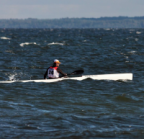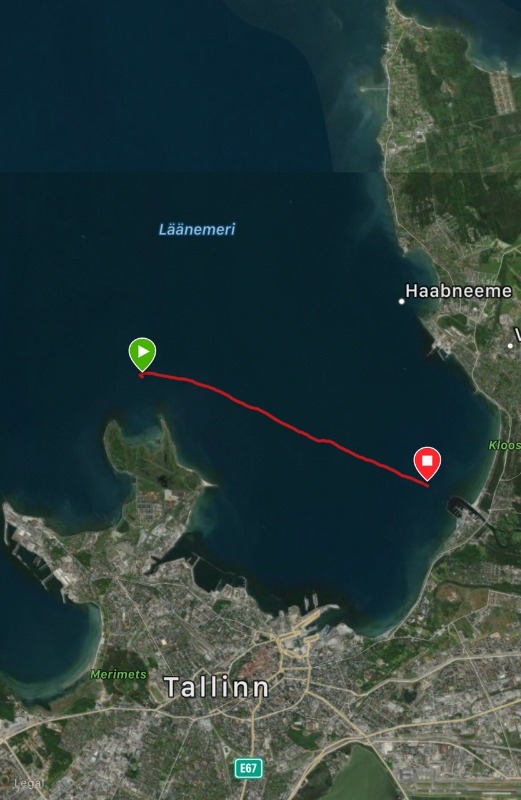- Posts: 526
- Thank you received: 42
Paddle float as a remount backup
- SpaceSputnik
- Topic Author
- Offline
- Platinum Member
I was practicing remounts at the end of my paddle a few days ago. I was tired and the wind picked up and i was was not having a 100% success rate. I have a decent idea where my technique needs work but it got me thinking that a plan B would be nice.
When I was sea kayaking in the past we always carried paddle floats. Self rescue with a float can be less straining than a remount and it should probably work with my V7.
Basically after dumping you slide a float over a paddle blade and inflate it. Than place the paddle at 90 degrees to the boat and hook it to the foot strap with your thumb. Then remount a stabilized boat while holding the paddle in-place and with the other hand on the far side of the bucket.
A deflated float is smaller than a rolled newspaper and can go on the rear deck under bungees. Sounds like something worth trying...
Please Log in or Create an account to join the conversation.
Although others may have differing opinions and experiences, I tend to disagree with this approach.
Surfskiing, in conditions other than calm, demands development of a “bomb-poof” remount. The paddle float, while potentially useful in some situations, would just delay your development of this potentially life-saving skill.
Yes, work on and develop the technique (in calm water) – watch the experts on the videos a hundred times and get some personal instruction if that is not enough for you.
Once you get your technique down, remember: Practicing remounts only in calm water when you are full of energy will only teach you to get good at remounting in calm water when you are full of energy, i.e., not really when you need to remount.
So you say you “were practicing remounts at the end of my paddle …. I was tired and the wind picked up”: Excellent!, that is a great time to practice. The only addition I would make is to do it right near shore, with the wind/waves pushing you towards shore if you have problems.
When I was learning all this, it appeared to me that, if it took me 3 times to remount in a given set of conditions, I was in conditions that were beyond my current skill level for the particular surfski I was in. So, back off into lesser conditions, get your remount down pat, then increase the conditions to continue developing the remount.
I realize that you could find yourself in rougher water than you originally intended; that is why it is so important, in my opinion, to gradually increase the max conditions you to which are exposed to as you learn to both paddle and remount. From my experience, you should progress to rougher water only when you get your remount down to the 1st attempt, but definitely no more than 2 trys for a given set of conditions.
It may sound difficult to believe, but remounting in eight to ten foot seas, while incredibly intimidating at the outset when beginning to surfski, is really not that hard if you work up to it.
Please Log in or Create an account to join the conversation.
- SpaceSputnik
- Topic Author
- Offline
- Platinum Member
- Posts: 526
- Thank you received: 42
The way I approach it is exactly like you say. I have a couple of protected spots on lake Ontario where it's mostly calm. When I end up in a bit of a chop I immediately ask myself if I can remount in this conditions and retreat accordingly.
However, it's not always predictable even with best of mindset. I continually find that even when forecast calls for a calm day, there's always local wind corridors where the conditions are not consistent with the forecast. It's easy enough to make a judgement error and end up where you really didn't intend to be. I carry a phone and a VHF radio, but rather self-rescue in this type of scenario and get the heck out.
Please Log in or Create an account to join the conversation.
But assuming you've got a workable plan for this, then yeah, go for it, and practice it lots. Years ago Rob posted a story about a guy getting overwhelmed on the Miller's run and swimming around in the dark while his buddies worried that he was a goner. Don't want to be that guy!
Please Log in or Create an account to join the conversation.
- SpaceSputnik
- Topic Author
- Offline
- Platinum Member
- Posts: 526
- Thank you received: 42
Probably takes a 10-15 seconds....
So the sequence would be something like
- remount, sit up
- a stroke on one side, swing one leg over to the other side so legs out on both sides (both legs on one side is much less stable, I do agree)
- Twist off the caps to let the air out (it goes out really fast), undo the buckle, throw the deflated float into the ski,
You can take an occasional stroke on the free side to keep moving during those 10-15 seconds
- legs in, go full blast.
So, the question if you can last 10-15 seconds legs out both sides with an occasional stroke on one side. Sounds like a fighting chance to me, no?
Please Log in or Create an account to join the conversation.
- SpaceSputnik
- Topic Author
- Offline
- Platinum Member
- Posts: 526
- Thank you received: 42
Please Log in or Create an account to join the conversation.
Your ability to remount in rough water should at least equal, and preferably exceed your ability to paddle in that rough water. If it does not, and you fall out, and then use the float to get in (because perhaps you have tried remounting a couple times and cannot do it), you are still stuck in the same rough water that caused you to fall out in the first place, and so, you are quite likely to fall out again.
This could set up a cycle of falling in and remounting over and over. I suspect I do not have to tell you how exhausting multiple remount attempts in rough water can be.
I realize conditions can change quickly – I don’t know Lake Ontario but I have little doubt about what you are saying – but that only reinforces my belief that one should if possible practice in rough conditions in a “controlled” place, perhaps right off shore with an onshore wind.
If you are going far enough out where it may get dangerously rough beyond your skill level, you should not be going there, yet.
A recommendation might be to go out when there are onshore wind/waves a little stronger than what you are used to, but just go out a couple hundred yards offshore – then dump yourself, remount, repeat. Again, and again. The worst that can happen is you can’t get in and you and the boat get pushed back to shore.
When I was learning I would go a few hundred yards off shore with increasing wind and waves and paddle giant figure 8s. If I stayed in, great – I was developing paddle skills with wind and waves hitting me at all angles on the ski. If I fell out, great – I learned how to get in for that set of conditions. Either way, I could advance a bit further in rougher conditions the next time.
You will “get it” all, it just takes practice. There is no substitute for learning in rough water than by practicing in rough water.
Please Log in or Create an account to join the conversation.
- SpaceSputnik
- Topic Author
- Offline
- Platinum Member
- Posts: 526
- Thank you received: 42
Just to elaborate on my own practices. The conditions I am usually in are laughable by most of you guys on this site. I am quite frankly the most cautious paddler I know
Please Log in or Create an account to join the conversation.
Please Log in or Create an account to join the conversation.
- zachhandler
-

- Offline
- Platinum Member
- Posts: 797
- Thank you received: 200
Current Skis: Nelo Vanquish AIR, Epic V10g4, NK 670 double, NK exrcize, Carbonology Feather, Think Jet, Knysna Sonic X
Former Skis: Epic v10g3, Kai Waa Vega, Epic V12 g2, Epic V12 g1, Epic v10 double, Nelo 550 g2, Fenn Elite S, Custom Kayaks Synergy
Please Log in or Create an account to join the conversation.
- SpaceSputnik
- Topic Author
- Offline
- Platinum Member
- Posts: 526
- Thank you received: 42
On a kayak, you do not secure a paddle under a line, you hook it on a deck line with a thumb while the blade rests on side/top of the deck. Basically the same idea, so I am optimistic.
Please Log in or Create an account to join the conversation.
- zachhandler
-

- Offline
- Platinum Member
- Posts: 797
- Thank you received: 200
Current Skis: Nelo Vanquish AIR, Epic V10g4, NK 670 double, NK exrcize, Carbonology Feather, Think Jet, Knysna Sonic X
Former Skis: Epic v10g3, Kai Waa Vega, Epic V12 g2, Epic V12 g1, Epic v10 double, Nelo 550 g2, Fenn Elite S, Custom Kayaks Synergy
Please Log in or Create an account to join the conversation.
- SpaceSputnik
- Topic Author
- Offline
- Platinum Member
- Posts: 526
- Thank you received: 42
Please Log in or Create an account to join the conversation.
David
Please Log in or Create an account to join the conversation.
"Success is not final, failure is not fatal: it is the courage to continue that counts." - Winston Churchill
Please Log in or Create an account to join the conversation.
- SurfskiEstonia
-

- Offline
- Premium Member
- Posts: 122
- Thank you received: 15
This was the first season for me to paddle offshore, before 2 seasons of back-n-forth on the beach. My usual downwind track looks like this:
In the middle section of this track I'm at an equal distance (2-3 km) from shore. I paddle a Nelo Ocean ski which I read is between V12 and V14 in terms of stability. The remount is not very gracious, but I usually manage to do it. I carry a flare and a mobile phone with me. But in case there is an emergency it may take more than half an hour for the rescue to reach me. So I was thinking about a bad scenario plan B. I don't go out with the water temp under 16*C, but as the recent case in NZ showed, that's still not warm enough.
What do You guys think about something like on this drawing below (sorry, I'm not FasterFather
It could be a measure of last resort when the fatigue kicks in and the hypothermia is imminent, this could maybe save someone's life? Is this at all feasible?
Current: Carbonology Boost double, Jantex Gamma Mid
Previous: Nelo Ocean Ski L, Jantex Gamma Rio Large Minus
Please Log in or Create an account to join the conversation.
- SpaceSputnik
- Topic Author
- Offline
- Platinum Member
- Posts: 526
- Thank you received: 42
Now I just treat fatique as one of the risk factors. After all if I go over unintentionally once I would probably go over again and basically shouldn't be where I am, so I plan to get back to the launch point earlier than the very end of my distance and rack up the remaining kms in a safe place.
Having said that, a safety device is a safety device. You could probably rig up something like what you have shown just don't know how you would attach the hinge to the hull so it takes the load.
PS Spent a few summers in Tallinn area as a kid. Love the area.
Please Log in or Create an account to join the conversation.
- SurfskiEstonia
-

- Offline
- Premium Member
- Posts: 122
- Thank you received: 15
Current: Carbonology Boost double, Jantex Gamma Mid
Previous: Nelo Ocean Ski L, Jantex Gamma Rio Large Minus
Please Log in or Create an account to join the conversation.
Latest Forum Topics
-
- Paddling with rotator cuff injury
- 3 hours 46 minutes ago
-
- Nelo Vanquish AIR review
- 1 day 1 hour ago



